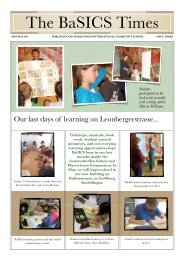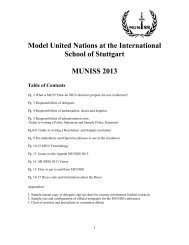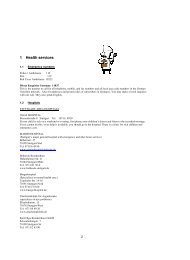Parent Teacher Association
Parent Teacher Association
Parent Teacher Association
Create successful ePaper yourself
Turn your PDF publications into a flip-book with our unique Google optimized e-Paper software.
About Stuttgart<br />
History of the city<br />
Stuttgart was originally a stud farm for horses and was probably founded by Duke Liutolf of Swabia, a<br />
son of emperor Otto the Great, in 950. “Stuotgarten” or “Stutengarten” (Mare’s Garden) was the name<br />
given to the settlement which grew up around this stud farm and was first recorded in1160. The Stuttgart<br />
coat of arms, a black horse about to leap on a gold backcloth, is a link back to this stud farm.<br />
Stuttgart received its municipal charter around 1219. Up to 1495, it was the residence of the Counts of<br />
Württemberg, from 1495 to 1803 the residence city of the Duchy, from 1803 to 1805 the seat of the<br />
electorate and from 1806 to 1918 the residence of the Kingdom of Württemberg.<br />
In 1918, Stuttgart was made the capital of Württemberg, in 1945 of Württemberg-Baden, and in 1952 of<br />
the newly formed Federal State of Baden-Württemberg, the third largest in the Federal Republic.<br />
Today’s Stuttgart<br />
The Capital of Baden-Württemberg is the heart of the region. Stuttgart is uniquely situated in a valley<br />
with steeply rising hillsides. Surrounded on three sides by wooded hills, opening to the east towards the<br />
river Neckar, the city enjoys a pleasant climate. The vineyards reach as far as the inner city. The many<br />
parks, forests and sloping vineyards confirm Stuttgart’s renown as one of the most beautifully situated<br />
cities in Europe – some 11.000 hectares (26.000 acres), half of its total area, are made up of forest, parks,<br />
fields, vineyards and gardens.<br />
The city has a world-wide reputation as one of the most economically important major cities in Europe.<br />
Two universities, three technical colleges and institutes of international acclaim ensure the close bonds<br />
between practice and research.<br />
Stuttgart has always been the intellectual and cultural hub of the state.<br />
The city is a model example for the cultural opportunities it offers. For example:<br />
Attested by the numerous museums and galleries, in particular the New State Gallery built by the British<br />
architect James Sterling.<br />
The concert, ballet and theatre life of the city is of a comparably high standard.<br />
Stuttgart is also known as the “city of books” and has about 150 publishing houses and as many book<br />
shops. (A German record). Major functions and sports events are held in the Hanns-Martin-Schleyer-<br />
Halle and in the Culture- and Congress Center Liederhalle.<br />
Completely different standards are set by the international trade fairs and exhibitions on Killesberg. For<br />
example, the Stuttgart International Fair is the annual stage for the CMT International Tourist Exhibitions.<br />
Friendly Swabian wine bars, restaurants for all tastes foreign cuisine, as well as pubs, bistros,<br />
discotheques and night clubs keep life on the move in the city.<br />
0







